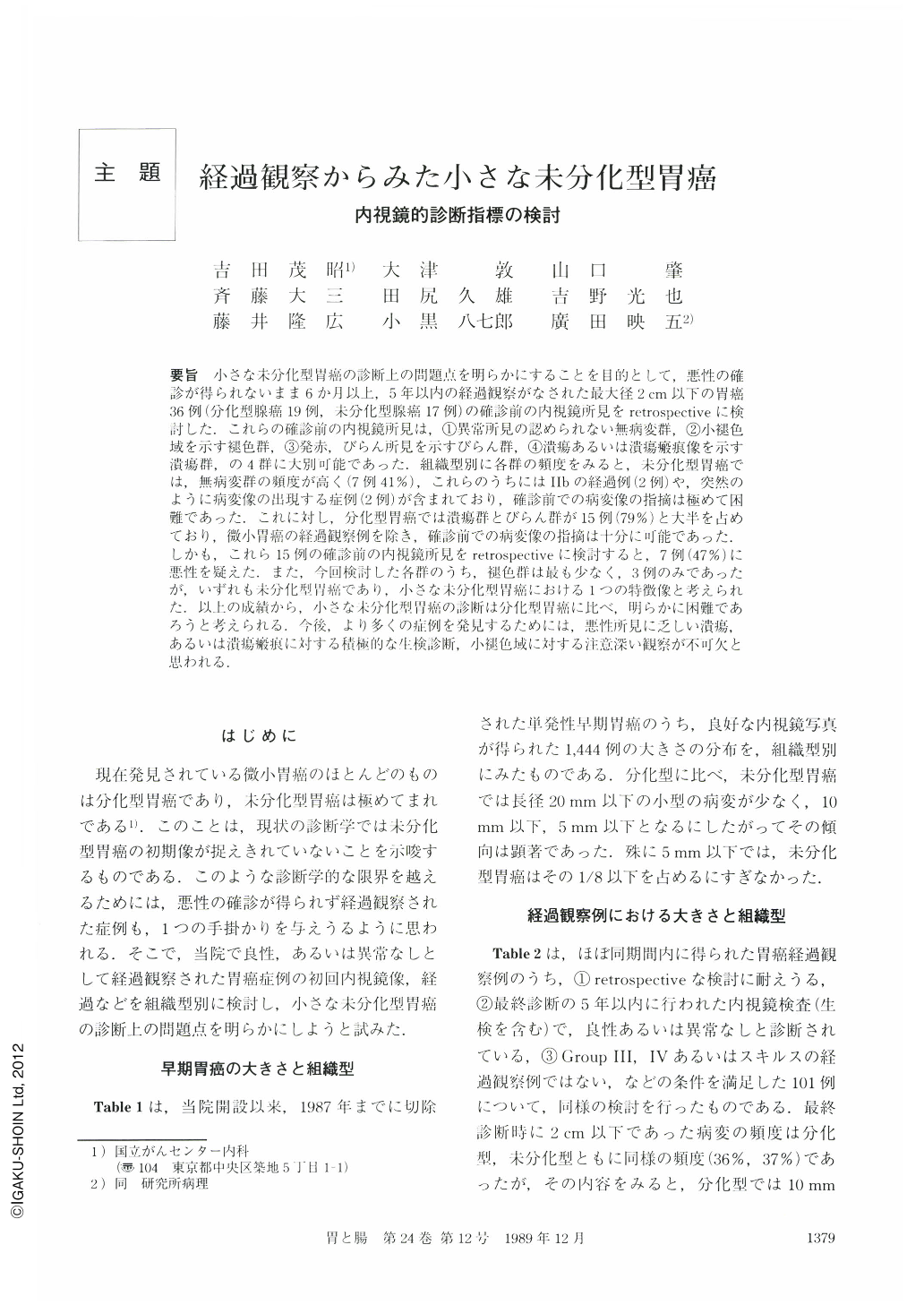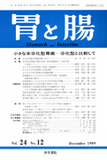Japanese
English
- 有料閲覧
- Abstract 文献概要
- 1ページ目 Look Inside
- サイト内被引用 Cited by
要旨 小さな未分化型胃癌の診断上の問題点を明らかにすることを目的として,悪性の確診が得られないまま6か月以上,5年以内の経過観察がなされた最大径2cm以下の胃癌36例(分化型腺癌19例,未分化型腺癌17例)の確診前の内視鏡所見をretrospectiveに検討した.これらの確診前の内視鏡所見は,①異常所見の認められない無病変群,①小褪色域を示す褪色群,①発赤,びらん所見を示すびらん群,①潰瘍あるいは潰瘍瘢痕像を示す潰瘍群,の4群に大別可能であった.組織型別に各群の頻度をみると,未分化型胃癌では,無病変群の頻度が高く(7例41%),これらのうちにはⅡbの経過例(2例)や,突然のように病変像の出現する症例(2例)が含まれており,確診前での病変像の指摘は極めて困難であった.これに対し,分化型胃癌では潰瘍群とびらん群が15例(79%)と大半を占めており,微小胃癌の経過観察例を除き,確診前での病変像の指摘は十分に可能であった.しかも,これら15例の確診前の内視鏡所見をretrospectiveに検討すると,7例(47%)に悪性を疑えた.また,今回検討した各群のうち,褪色群は最も少なく,3例のみであったが,いずれも未分化型胃癌であり,小さな未分化型胃癌における1つの特徴像と考えられた.以上の成績から,小さな未分化型胃癌の診断は分化型胃癌に比べ,明らかに困難であろうと考えられる.今後,より多くの症例を発見するためには,悪性所見に乏しい潰瘍,あるいは潰瘍瘢痕に対する積極的な生検診断,小褪色域に対する注意深い観察が不可欠と思われる.
The proportion of undifferentiated (untubular) type of gastric cancer is quite small among minute lesions. In order to clarify the diagnostic difficulty in detecting small gastric cancers of undifferentiated type, endoscopic findings in follow-up cases of gastric cancer smaller than 2 cm in diameter were examined retrospectively. During the period between 1970 and 1987, 101 cases of gastric cancer were followed-up because it was undetermined whether the lesion was malignant or not at the previous examination performed within five years prior to the latest examination. Of the 101 cases 36 measured less than 2 cm on the resected specimen and were selected as the subjects of this study. The endoscopic findings observed at the previous examination (early endoscopic findings) in the 36 cases were grossly classified into the following four categories; 1) no abnormality detected (N.A.D.). 2) small discolored, 3) erosive and 4) ulcerative lesions.
Of the 36 cases 17 were undifferentiated and 19 differentiated (tubular) types of adenocarcinoma histologically. Among early endoscopic findings of the former type, category of N.A.D. was the most frequent (41%) and included two cases of Ⅱb (flat) type early gastric cancer measuring 1.5 and 2 cm, respectively. In these cases detecting abnormality was quite difficult even on the endoscopic pictures taken at the latest examination. Among other cases in this category, significantly large cancer lesions seemed to develop suddenly from no abnormal mucosa as seen in Case 1 (Figs. 1 and 2), except for a case of minute cancer sized 6 mm.
In contrast, among early endoscopic findings of the 19 cases of differentiated type, category of ulcerative lesion was the most frequent (47%), followed by that of erosive one (32%). In the 15 cases classified into these two categories detecting mucosal abnormality was easily done retrospectively as shown in Case 4. In 7 (47%) of these 15 cases, malignant nature of the lesion was suspected even on the endoscopic pictures taken at the previous examination. The remaining 4 of the 19 cases of differentiated type were classified into category of N.A.D., and 3 of these 4 cases had a minute cancer sized less than 5 mm.
The category of small discolored lesion as shown in Case 2 included only 3 cases and was the least frequent among the 4. All 3 cases, however, fell into undifferentiated type, and one (Case 3) of the 3 cases developed conventional Ⅱc from N.A.D. through small discoloration during the prospective follow-up period, indicating that the small discoloration is characteristic to undifferentiated type of gastric cancer, as reported in the previous literatures.
The above results suggest that detecting undifferentiated type small gastric cancer is much more difficult than that for differentiated one. In order to detect small undifferentiated type gastric cancer, cautious observation for small discoloration or biopsy from benignlooking or erosive lesion is indispensable.

Copyright © 1989, Igaku-Shoin Ltd. All rights reserved.


